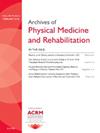Enhancing Spinal Cord Injury Care: Using Wearable Technologies for Physical Activity, Sleep, and Cardiovascular Health
IF 3.6
2区 医学
Q1 REHABILITATION
Archives of physical medicine and rehabilitation
Pub Date : 2024-10-01
DOI:10.1016/j.apmr.2024.06.014
引用次数: 0
Abstract
Wearable devices have the potential to advance health care by enabling real-time monitoring of biobehavioral data and facilitating the management of an individual's health conditions. Individuals living with spinal cord injury (SCI) have impaired motor function, which results in deconditioning and worsening cardiovascular health outcomes. Wearable devices may promote physical activity and allow the monitoring of secondary complications associated with SCI, potentially improving motor function, sleep, and cardiovascular health. However, several challenges remain to optimize the application of wearable technologies within this population. One is striking a balance between research-grade and consumer-grade devices in terms of cost, accessibility, and validity. Additionally, limited literature supports the validity and use of wearable technology in monitoring cardio-autonomic and sleep outcomes for individuals with SCI. Future directions include conducting performance evaluations of wearable devices to precisely capture the additional variation in movement and physiological parameters seen in those with SCI. Moreover, efforts to make the devices small, lightweight, and inexpensive for consumer ease of use may affect those with severe motor impairments. Overcoming these challenges holds the potential for wearable devices to help individuals living with SCI receive timely feedback to manage their health conditions and help clinicians gather comprehensive patient health information to aid in diagnosis and treatment.
加强 SCI 护理:利用可穿戴技术促进身体活动、睡眠和心血管健康。
可穿戴设备能够实时监测生物行为数据,促进对个人健康状况的管理,因而具有推动医疗保健发展的潜力。脊髓损伤(SCI)患者的运动功能受损,导致体能下降和心血管健康状况恶化。可穿戴设备可以促进体育锻炼,监测与脊髓损伤相关的继发性并发症,从而改善运动功能、睡眠和心血管健康。然而,要优化可穿戴技术在这一人群中的应用,仍面临一些挑战。其一是在成本、可及性和有效性方面实现研究级设备和消费级设备之间的平衡。此外,支持可穿戴技术在监测 SCI 患者的心肺功能和睡眠方面的有效性和使用的文献有限。未来的发展方向包括对可穿戴设备进行性能评估,以精确捕捉 SCI 患者运动和生理参数的额外变化。此外,努力使设备体积小、重量轻、价格低,便于消费者使用,可能会对严重运动障碍患者造成影响。克服了这些挑战,可穿戴设备就有可能帮助患有 SCI 的人及时获得反馈,以管理他们的健康状况,并帮助临床医生收集全面的病人健康信息,以帮助诊断和治疗。
本文章由计算机程序翻译,如有差异,请以英文原文为准。
求助全文
约1分钟内获得全文
求助全文
来源期刊
CiteScore
6.20
自引率
4.70%
发文量
495
审稿时长
38 days
期刊介绍:
The Archives of Physical Medicine and Rehabilitation publishes original, peer-reviewed research and clinical reports on important trends and developments in physical medicine and rehabilitation and related fields. This international journal brings researchers and clinicians authoritative information on the therapeutic utilization of physical, behavioral and pharmaceutical agents in providing comprehensive care for individuals with chronic illness and disabilities.
Archives began publication in 1920, publishes monthly, and is the official journal of the American Congress of Rehabilitation Medicine. Its papers are cited more often than any other rehabilitation journal.

 求助内容:
求助内容: 应助结果提醒方式:
应助结果提醒方式:


